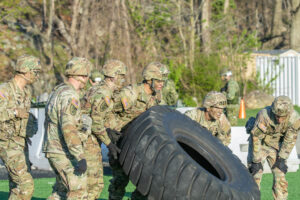GED for military is an important topic to consider if you’re looking to join the armed forces without a traditional high school diploma. While a GED (General Education Development) test can serve as an alternative to a high school diploma, it’s important to understand how this credential is viewed by military branches, such as the Army, Air Force, and Marine Corps, as well as how it affects your eligibility for various career opportunities within the military.
Earning a GED involves passing a series of tests administered by the GED Testing Service at authorized testing centers nationwide. Compared to a traditional high school diploma, GED holders can face additional requirements and restrictions when seeking to join specific branches of the armed forces. This is because military branches have educational requirements that help ensure recruits have the necessary skills to succeed in their career path. Completing the ASVAB test (Armed Services Vocational Aptitude Battery), for example, is a mandatory step for all military applicants regardless of their educational background.
Aside from the educational requirements, a GED can impact your chances of joining particular military branches due to the military’s classification of recruits into tier groups. Only a small percentage of open positions are allocated to GED holders, as they fall into Tier 2, while those with high school diplomas are classified as Tier 1 applicants. It’s important to note that, in recent years, less than one percent of annual recruits joining the military held a GED. Therefore, it’s crucial to be well-prepared, score highly on the ASVAB, and meet all other requirements to improve your chances of enlisting with a GED.
Understanding the Importance of GED for Military

Joining the military is a noble and rewarding career choice, but there are certain educational requirements you must meet in order to enlist. One of those requirements is having a high school diploma or a General Education Development (GED) credential. Obtaining your GED for military enlistment is vital and shows your commitment to both your education and your country.
The Armed Forces primarily classify applicants into three tiers based on educational achievements. A Tier 1 status is awarded to those with a high school diploma, while Tier 2 includes individuals with a GED or other high school equivalency credentials. Tier 3 applicants are those without a high school diploma or GED. The military prefers Tier 1 applicants and accepts less than one percent of Tier 3 applicants annually.
To join the military with a GED, you must also pass the ASVAB test (Armed Services Vocational Aptitude Battery), which is used to determine your eligibility for specific job roles within the military. This aptitude test assesses your knowledge in subject areas such as arithmetic reasoning, general science, and mechanical comprehension. A higher ASVAB score usually translates to more open positions for enlistment, so it’s crucial to prepare for and do well on this test.
Each branch of the Armed Forces – the Army, Air Force, Navy, Marine Corps, and Coast Guard – sets its own minimum ASVAB scores for enlistment. For example, the Army requires a minimum ASVAB score of 31 for applicants who completed high school, but GED holders must achieve a score of 50 to qualify.
In addition to meeting ASVAB requirements, some branches of the military may also require GED holders to complete a certain number of college credit hours before enlisting. This policy is due to the military’s preference for high school graduates over GED holders, as only a limited number of GED recipients are accepted into each military branch annually.
Here’s a quick overview of the college credit requirements for some military branches:
- Army: 15 college credit hours
- Air Force: 15 college credit hours
- Navy: No additional college credits required
- Marines: No additional college credits required
- Coast Guard: 15 college credit hours
Completing these college credits not only improves your chances of enlisting but may also lead to better career opportunities in the military. Taking relevant college courses can help build your knowledge and skills in fields that align with your desired military occupation.
Exploring the Different Branches of Military Service

When considering a GED for military service, it’s essential to understand the various branches of the armed forces and their respective requirements. Each military branch has different expectations when it comes to educational background, test scores, and other qualifications. So, let’s dive into the specifics of what each branch seeks in recruits with a GED.
The U.S. Army typically accepts applicants with a GED, although individuals with a high school diploma have more opportunities available. The Army requires a passing score on the Armed Forces Qualification Test (AFQT) to join, so GED holders should prepare adequately. Additionally, GED holders may have to meet higher ASVAB score requirements for certain military occupational specialties (MOSs).
The U.S. Navy is known for having stringent educational requirements, with less than one percent of annual recruits being GED holders. If you’re looking to join the Navy with a GED, a strong performance on the ASVAB test is crucial. High ASVAB scores will bolster your chances of being accepted and may open up more job opportunities.
The U.S. Air Force accepts a limited number of GED holders, as they prefer recruits with a regular high school diploma. Should you wish to join the Air Force with a GED, you’ll need to excel on the ASVAB test to increase your chances. It’s also recommended that GED holders complete some college credits, as this helps increase their standing compared to high school diploma holders.
The U.S. Marine Corps accepts GED holders into their ranks, but doing so comes with some caveats. They categorize GED recipients as “Tier 2” applicants, putting them at a slight disadvantage for enlistment. Fierce competition means a higher emphasis on ascertaining ASVAB scores, so focus on achieving a solid performance on this aptitude test.
Lastly, the U.S. Coast Guard is the most selective branch when it comes to GED holders. They’ll generally consider GED recipients who have completed at least 15 college credit hours. Scoring well on the ASVAB test is essential to stand a chance.
In summary, each branch of the military has different standards and expectations for recruits with a GED. To maximize your chances, it’s crucial to:
- Perform well on the ASVAB test
- Consider completing college credits
- Research the specific requirements of your desired military branch
Eligibility Requirements for Military Enlistment with a GED
Joining the military with a GED can be an alternate pathway if you don’t have a high school diploma. However, each branch of the armed forces has its own set of educational requirements, so it’s important to know those before planning your military career. In this section, we’ll discuss the requirements for enlisting in the military with a GED.
The Armed Forces Qualification Test (AFQT) measures the knowledge and aptitude of potential recruits. The test is a portion of the Armed Services Vocational Aptitude Battery (ASVAB), which determines eligibility for specific military jobs. A good score on the AFQT is necessary for anyone with a GED to be considered for enlistment.
Apart from the ASVAB scores, each military branch has its own set of requirements for enlisting with a GED. Here’s a brief overview:
- Army: GED holders can join the Army, but the number of annual recruits with GEDs is limited. Earning 15 college credits from a community college or other accredited institution will increase your chances of enlisting.
- Navy: A GED is accepted, but often with specific requirements, such as higher ASVAB scores. Gaining some college credits is recommended to improve eligibility.
- Air Force: The Air Force has the strictest requirements, with less than 1% of recruits being GED holders. However, completing 15 college credit hours can improve your chances of enlisting.
- Marine Corps: GED holders can enlist, but they will need to score higher on the ASVAB test. As with other branches, earning college credits can increase your odds of being accepted.
- Coast Guard: This branch has limited acceptance of GEDs, so earning some college credits is highly recommended to boost your chances of enlisting.
It’s important to note that your GED test scores matter when considering eligibility requirements for military enlistment. High school graduates have a wider range of options when it comes to career opportunities within the military. GED holders, on the other hand, may have a more limited selection of jobs.
Ready to take the GED test? Locate testing centers through the GED Testing Service website. Prepare for the exam by studying the subject areas that will be covered, such as arithmetic reasoning, general science, and more.
Tips for Preparing for the GED Test

Pursuing a GED for military service can be a great alternative to a high school diploma. As you prepare to take the GED test, it’s crucial to utilize effective study strategies and techniques to increase your chances of success. Here are some valuable tips to help you conquer your GED exam and enlist in the military with a GED in hand.
Before diving into your GED preparations, familiarize yourself with the general education development test structure and content. The GED test is divided into four main subject areas: mathematical reasoning, reasoning through language arts, science, and social studies. Focus on these areas to ensure a comprehensive understanding of the material on the test.
Once you’re familiar with the test, create a study plan that targets your individual strengths and weaknesses. Make sure to spend ample time on subject areas that require more attention, and don’t neglect subjects where you feel confident. You can find practice tests and study materials through the GED Testing Service or by taking college courses at a local community college.
Next, consider joining a GED test prep course, either online or in person. These courses can provide a structured learning environment with experienced instructors and resources, including practice tests to better gauge your readiness. Practice mock tests help simulate the actual testing experience and can offer valuable insights into your progress.
To further enhance your preparations, find a study group or enlist the help of a tutor. Studying with others can help keep you accountable and offer opportunities to discuss and clarify difficult concepts. A tutor can provide personalized guidance to address your specific challenges.
Lastly, don’t forget to take care of yourself as you prepare for the GED exam. Ensure you’re getting enough sleep, eating well, and engaging in regular exercise to keep your mind sharp and focused. Establishing a healthy routine will eventually benefit you when taking the GED test and enlisting in the military with a GED afterwards.
In addition to preparing for your GED test, it’s essential to be aware of each military branch’s GED requirements. For instance, the Army, Navy, Air Force, Marine Corps, and Coast Guard have varying educational requirements and ASVAB score minimums for applicants with GEDs. Research your desired branch’s requirements and ensure your score meets or exceeds their standards, to boost your chances of being considered for relevant armed forces positions.
Resources to Help Military GED Candidates Succeed
If you’re considering the GED for military enlistment, it’s crucial to know the educational requirements and resources available to help you succeed. Not having a high school diploma can be a challenge, but obtaining your GED is a great alternative. This section will guide you through various resources for GED candidates aiming to join the military.
The GED, or General Education Development test, is widely accepted in different branches of the military, such as the Air Force, Army, Navy, Marine Corps, and Coast Guard. However, keep in mind that each branch has specific standards regarding the Armed Forces Qualification Test (AFQT) and GED test scores. To boost your chances of enlisting, aim to score well above the minimum requirements on both the GED and AFQT.
You can take the ASVAB test, which stands for Armed Services Vocational Aptitude Battery, to determine your eligibility for joining the military. A high ASVAB score increases your chances of enlisting and allows you to choose from a broader range of military jobs. Some resources to help you prepare for the ASVAB test include:
- Online study guides and practice tests
- Learning centers that offer ASVAB preparation courses
- Books and materials available at local libraries and bookstores
To shift your focus toward the GED exam, contact your local GED Testing Service for guidance on preparation materials and finding testing centers. They will provide you with essential information about the test, including the test format, subjects, and scheduling. Some reputable resources for GED preparation are:
- The official GED website
- Online GED courses and study materials
- Adult education centers that offer GED test preparation
Enrolling in college courses can also help you prepare for the GED exam while earning college credit hours. This will not only help you in joining the military but also prove useful for your future educational pursuits.
Moreover, if you hold a certain number of college credits, the military may classify you as a Tier 1 recruit, which increases your likelihood of being accepted. An Army recruiter, for example, can provide you with more information on these requirements and benefits.
While preparing for your GED test and pursuing military enlistment, don’t hesitate to seek guidance from military personnel or veterans, as their valuable insights and experiences can aid your journey.
Conclusion: The GED Advantage in Your Military Career
Achieving a GED for military service offers several benefits for those looking to enter the armed forces without a high school diploma. In some branches of the military, such as the Air Force, having a GED rather than a high school diploma may have minimal impact on your eligibility for service. In fact, less than one percent of annual recruits are GED holders.
Here are some of the main advantages of obtaining a GED for military service:
- Expanded opportunities: The GED Test is designed to evaluate your knowledge in key subject areas, which can help you meet the educational requirements of certain military branches. This may result in a wider selection of open positions and specific jobs within the armed forces.
- Simplified enlistment: Adequate score on the GED exam meets the educational requirements set forth by the armed services, which can provide a faster means to join the military compared to completing a high school education.
- College credit hours: In addition to meeting the education criteria for joining the military, your GED scores might be used to gain college credits, allowing you to take fewer required courses for your higher education.
Preparing for the ASVAB test is necessary since the test scores are used to determine your eligibility for enlistment. Adequate preparation in Arithmetic Reasoning, General Science, and other subject areas can contribute to a good score in the ASVAB test to secure a spot in the military.
Remember that each military branch has different GED requirements, such as minimum ASVAB scores or the amount of college credit hours needed to qualify for service. It’s recommended to learn about GED Testing Service policies and speak with an Army, Navy, or Air Force recruiter to gain clarity on specific GED requirements for each branch.
Overall, getting a GED for military enlistment offers various advantages for an individual’s military and educational paths. Pursuing a GED demonstrates a commitment to personal growth and might open up more possibilities for career and educational advancement within the military. So, if you’re considering joining the military without a high school diploma, obtaining a General Education Development credential may be your best bet.
